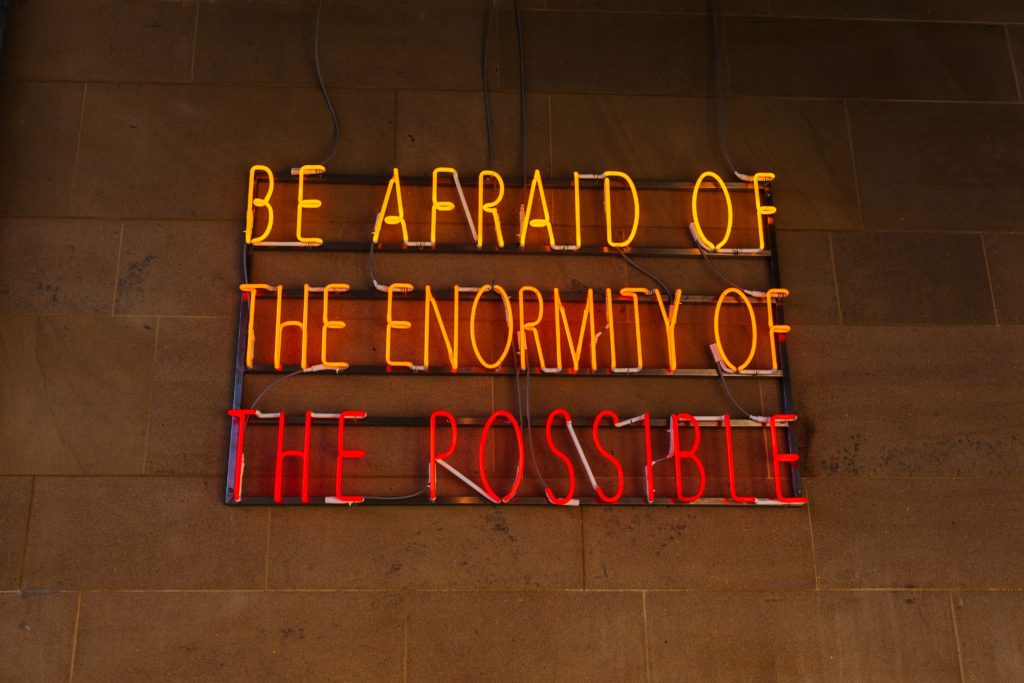Is When a Line of Poetry Continues Into the Next Line Without a Pause or a Break
STEP UP YOUR POETRY GAME WITH BETTER LINE BREAKS AND ENJAMBMENT
What makes a poem, a poem? Long story short, poetic line breaks. Of course, many other literary elements fuse to make poems croon, but poetry is visibly distinct from prose because its lines are sundered before the page's natural end, at clearly calculated points. Poems are dialogues between the presence that is the text and the absence that is the white space revealed.
In contrast, where a line ends in a prose piece is arbitrarily dictated by a page's margins. Hence why "prose poems," which don't utilize line breaks, are qualified by the word "prose." Every prose line runs blindly towards the brink, and once it bumps its head against the uniform white space of the margin (in LTR and RTL scripts), it starts again on the next line, replicating this headlong trajectory over and over until you have pages filled with blocks of text offset by only smidgen indents. Prose flows, but it doesn't care where it goes.
Although line breaks build poems, many "writers" have no damn clue how to use them effectively. If you're not taking advantage of the connotative dynamism and aesthetic value of ink abutting blankness afforded by poetic line breaks, you're not writing the best poetry. In fact, you're not writing poetry at all.
POETIC LINE BREAKS DEFINITION

First off, let's define a poetic line break. Quite simply:
A poetic line break is the deliberately placed threshold where a line of poetry ends and the next one begins.
Remember, there's a difference between a "line" and a "sentence." A sentence is that grade-school tool that expresses a complete thought. A line is the literal linear streak of text flowing across a page. A line is a container for sentences. A line is a boa constrictor stretched across a paper road, and a sentence is the still-whole squirrel in its belly.Here are some rules to remember about lines and sentences. (The / below represents poetic line breaks and is useful in environments such as this, where space is malleable and digital devices distort).
A poetic line can contain a complete sentence:

A poetic line can also contain multiple sentences:

A poetic line can also contain a sentence and an incomplete sentence:

Or multiple sentences and an incomplete sentence:

Or just an incomplete sentence:

Or even several incomplete sentences:

Already you can see that there's much we can do within a poetic line. Think of a line as container, a bottle. Inside it, we let sail small ships of sentences and their fragment dinghies.
ENJAMBMENT IS THE KEY TO THE BEST POETIC LINE BREAKS

Now we get to the good stuff (*rubs hands gleefully*). Poetic line breaks can be just as boring as prose's headlong flow if we schism every line at an "end stop." An "end stop" is just another word for a period, and a period is just a little black dot that indicates that a sentence is complete. If we end at such an obvious end, our poetry becomes predictable, and this is a no-no because poetry's greatest offering is linguistic eurekas. Thus, rather than breaking our lines at the end of each complete sentence, we should "enjamb" them.
Enjambment births sentence fragments, multi-dimensional meaning, and visual appeal through the unexpected intrusion of white space. Enjambment's power isn't a secret, but many "poets" — perhaps including you, dear reader — don't fully capitalize on its potential — or worse, use it poorly. In a walnut-shell, I think of enjambment like this:
Enjambment is the point where a sentence fissures and continues on to the next poetic line."
Let's see how others define enjambment:
The running-over of a sentence or phrase from one poetic line to the next, without terminal punctuation; the opposite of end-stopped."
-The Poetry Foundation
Enjambment, also called run-on, in prosody, the continuation of the sense of a phrase beyond the end of a line of verse."
-Encyclopaedia Britannica
In other words, while I conceptualize enjambment as a point on the page, official definitions present it as a linguistic overflowing. Both modes of thinking about it are useful since enjambment's fruit really grows from the nexus of breaking and continued meaning. Considering the specific point at where the enjambment occurs can help you craft a more potent line break.
If you're still confused about the distinction between enjambment and poetic line breaks, here's an easy way to think about it.There are two types of poetic line breaks. One is end-stopped. The other is enjambed. Enjambed line breaks are poetic bullion.
Enjambment can also be thought of as the intimate, subtly interrupted conversation between the final word of the enjambed line, and the first word of the subsequent line. The preceding and following words, of course, chime in and contribute to the conversation, but the lover's dialogue happens between those final and first words.
Further, because the final word of an enjambed line bears the precariousness of the brink of white space — generally more white space than its successor — because it teeters on the edge of silence — the poet must ensure that every single end word resonates. This holds true even if the poetic line break is end-stopped, but that little pebble that is a period makes the end-stopped line less vulnerable to the massive blank silence that enjambed final words are exposed to. Similarly, the first word of the subsequent line only has to bear the antecedent uniform margin/gutter, though of course this can be played with via indents and stanza breaks, but we'll save that for another day.
RULES FOR POETIC LINE BREAKS
In any case, in every case, each poetic line break depends upon a critical choice in diction, and an awareness of its ripple effect in sound and meaning. Here are some mandatory tips to achieve the best poetic line breaks:

Never end a poetic line on an article ( a/an, the ). The result will be incompleteness, rather than dynamic tension.
Never end a poetic line on a conjunction ( and, or, so, nor …). It's better to have such words at the start of the next line, but it's even better to restructure the lines so that the conjunction lives hidden amid the momentum of livelier words.
Never end a poetic line on a pronoun ( I, me, mine, his, hers, theirs, yours …). These are words that accompany, not words that can jut proudly like a figurehead on a ship's prow.
Try really hard not to end a poetic line on a preposition. The effect is similar to enjambing on articles and conjunctions, though sometimes the broken prepositional phrase can be interesting.
Line break on unusual nouns and verbs that ring strong as standalone words. As we discussed in 8 Key Literary Elements in Every Written Masterpiece, linguistic poignancy is always crucial, but it becomes critical when the strength of your diction is tested by a page's white space.
However, be aware that enjambment can rejuvenate common, tired words (light, home, breath, and so on) like no other poetic device. Strategic line breaks are a rare opportunity to reclaim these words from their historical overuse by imbuing them with variegated connotations.
Line break at a rhythmic point to poise meaning and weave a sonic tapestry. Luckily, poetry has shed its rhyming knickers, but that doesn't mean you can't play with rhyme, rhythm, and so on sporadically, internally, and effectively via the pauses and acoustic cascades created by poetic line breaks. At the same time, these pauses are sonic cues to read differently, allowing for distinctions and additions in the meaning of your words, fragments, and sentences.
POETIC LINE BREAKS IN ACTION
Let's see an example where an opportunity for enjambment isn't capitalized upon:
Example A:

*Shakes head sadly.*
If you're a poet, you should be having a panic attack at the missed opportunities here. And yet, I can't tell you how many workshop — and published — poems I've read that miss these opportunities every single time, every single line. If we instead write:
Example B:

The poem grows a hydra-head of new meanings. Enjambing on "night" means that the container of the first line now holds the idea of dusk becoming electrifying night in the room because the reveal of the artificial night "light" is delayed by the mid-sentence poetic line break. Thus, in Example B, dusk is transformed into both the captivating night as a time of day and the literal night light that gets plugged into electrical sockets, while Example A only illustrates the latter.
Further, in example A, the second line shoots its shot all in one go; there's no room for surprise. In contrast, Example B's second line contains an entirely new idea because of where the line begins and end: not only are we gifted the image of the throbbing night light, and later, lost time found in the shadows, we are also given "light throbbing and lost" as an unexpected standalone nugget of meaning simply because I enjambed on the words "night" and then "lost." This image does not exist in Example A because it wasn't extracted through the clarity of blank space strategically created via enjambment.

Yet another dimension in meaning in Example B is achieved through the 2nd line break on "lost", which creates the final container of "time found in the shadows." In contrast with Example A, there's an extra gain in Example B — not only has "lost time been found in the shadows," time itself — and thus double time, extra time — is found there as well thanks to enjambment.
These are just a few lines, so imagine what you can do in a whole poem if you wield poetic line breaks, and more specifically, enjambment, effectively. They are tools that allow you to whittle little poems within your larger piece.
It's important to note that enjambment doesn't remove meaning; it simply adds different meanings. All of the ideas in Example B are present in Example A, but B contains at least three other meanings because of two simple line breaks. At the same time, be aware that you will often have to choose between additional meanings when employing enjambment. Breaking on one word versus another may create an alternative, equally powerful sub-meaning, and this is when you have to consider what enjambed connotation works better within the context of your entire poem.
Also keep in mind that poetic line breaks are an editing tool; they generally come after you first scribble down your creation. This is true for several reasons. If you hand-write your first drafts, the lines will likely sprawl out with much wider spacing than what will be in their final typeset form. When the poem gets transferred to the computer, its entire appearance changes — and since the conversation between all of a poem's line breaks and the resulting white space result in an aesthetic that's intrinsic to the poem's effect, you can't polish those line breaks until you have a sense of what your poem will look like in its ultimate form.
Secondly, regardless of the mechanics of your composition, editing is a process of both adding and cutting content, so entire lines and words can disappear or rear their heads, drastically altering the look of your poem, and the corresponding enjambment. If you try to edit according to predetermined poetic line breaks, you're going to end up with a tortured piece whose corset is too tight to allow its words to breathe.
Poetic line breaks add to a more fulfilling experience, both from a creative perspective for you as an artist, and for your readers, breathing close to pages filled with your words as their night lights throb on and off, on and off.
Source: https://notesofoak.com/discover-literature/poetic-line-breaks-guide/
0 Response to "Is When a Line of Poetry Continues Into the Next Line Without a Pause or a Break"
Enviar um comentário